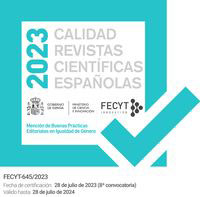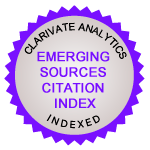Autocuidado en profesionales que trabajan con mujeres supervivientes de la violencia de género: un análisis temático
DOI:
https://doi.org/10.14198/fem.2025.46.08Palabras clave:
Autocuidado, violencia de género, impacto sobre profesionales, servicios especializados de violencia, bienestar profesional, salud laboral, violencia de segundo orden, análisis temáticoResumen
Esta investigación analiza el autocuidado en profesionales que trabajan con mujeres supervivientes de la violencia de género. El objetivo es identificar el significado y las estrategias de autocuidado, así como las dificultades que enfrentan y los recursos que tienen a su disposición. Se realizaron cuatro grupos de discusión entre junio y octubre de 2023 en la Región de Murcia y Castilla La Mancha en formato presencial y online. Se utilizó un guion de preguntas elaborado ad hoc. El criterio de inclusión fue trabajar o haber trabajado en la atención a mujeres supervivientes de violencia de género. Participaron en total 40 profesionales de la psicología y del trabajo social, en su mayoría mujeres, con una edad media de 40 años y una media de 7 de años de experiencia en intervención en este campo. Se realizó un análisis temático siguiendo el modelo propuesto por Braun y Clarke (2006). El proceso de análisis implicó categorizar los datos e identificar patrones y temas emergentes que, concretamente, fueron: «El autocuidado como necesidad», «Cuidar daña», «Barreras para el autocuidado», «Expuestas a violencia» y «Demandas a la organización». Cada tema ofrece una visión detallada sobre cómo este conjunto de profesionales practica el autocuidado, las dificultades estructurales que afrontan, la violencia que reciben, su estado de salud y los cambios que proponen para incorporar el autocuidado en las organizaciones. El discurso se articula en una tensión entre lo individual y lo social, donde el autocuidado personal no puede entenderse sin considerar el poder que ejerce la institución sobre el trabajo. El cuidado de aquellas personas que apoyan a las mujeres víctimas promueve el bienestar profesional, contribuye a fomentar el buen trato hacia las usuarias y ayuda a prevenir la revictimización de las sobrevivientes. Es una parte esencial en la prevención de la violencia machista.
Financiación
Asociación Columbares. Proyecto de investigación sobre el autocuidado de profesionales en el ámbito de la violencia de género (Programa cuidarse para cuidar) Exp:101/2022/147/6, financiado por el Ministerio de Derechos Sociales y Agenda 2030.Citas
Báguena, M. J., Villarroya, E., Beleña, A., Díaz, A., Roldán, C., & Reig, R. (2001). Propiedades psicométricas de la versión española de la Escala Revisada de Impacto del Estresor (EIE-R). Análisis y modificación de conducta, 27, 581-604. https://dialnet.unirioja.es/descarga/articulo/7061433.pdf
Bailey, B., Eisikovits, Z., & Buchbinder, E. (2012). Battering men and their male therapists: The different and the similar. Journal of Family Violence, 27, 465-476. https://doi.org/10.1007/s10896-012-9433-5
Baker, E. K. (2003). Caring for ourselves: The therapist's guide to personal and professional well-being. APA. https://doi.org/10.1037/10482-000
Ben-Porat, A., & Itzhaky, H. (2009). Implications of Treating Family Violence for the Therapist: Secondary Traumatization, Vicarious Traumatization, and Growth. Journal of Family Violence 24, 507-515. https://doi.org/10.1007/s10896-009-9249-0
Benuto, L. T., Singer, J., Gonzalez, F., Newlands, R., & Hooft, S. (2019). Supporting those who provide support: Work-related resources and secondary traumatic stress among victim advocates. Safety and health at work, 10(3), 336-340. https://doi.org/10.1016/j.shaw.2019.04.001
Braun, V., & Clarke, V. (2006). Using thematic analysis in psychology. Qualitative research in psychology, 3(2), 77-101. https://doi.org/10.1191/1478088706qp063oa
Brend, D. M., Krane, J., & Saunders, S. (2020). Exposure to trauma in intimate partner violence human service work: A scoping review. Traumatology, 26(1), 127-136. https://doi.org/10.1037/trm0000199
Cayir, E., Spencer, M., Billings, D., Hilfinger Messias, D. K., Robillard, A., & Cunningham, T. (2020). "The Only Way We'll Be Successful": Organizational Factors That Influence Psychosocial Well-Being and Self-Care Among Advocates Working to Address Gender-Based Violence. Journal of interpersonal violence, 36, 11327-11355. https://doi.org/10.1177/0886260519897340
Cleary, E., Curran, D., Kelly, G., Dorahy, M. J., & Hanna, D. (2023). The meta-analytic relationship between secondary traumatic stress and vicarious posttraumatic growth in adults. Traumatology, 29, 36-45. https://doi.org/10.1037/trm0000373
Dorociak, K. E., Rupert, P. A., Bryant, F. B., & Zahniser, E. (2017). Development of the Professional Self-Care Scale. Journal of Counseling Psychology, 64, 325-334. https://doi.org/10.1037/cou0000206
Eizirik M, Schestatsky S, Kruel L & Ceitlin LH. (2011). Countertransference in the initial visit of women victims of sexual violence. Braz J Psychiatry, 33(1), 16-22. https://doi.org/10.1590/S1516-44462010005000019
Ellsworth, R. R. (2002). Leading with Purpose: The New Corporate Realities. Stanford University Press. https://doi.org/10.1515/9780804765992
Expósito Jiménez, F., & Alonso Ferre, M. (2022). Guía de autocuidado para profesionales que trabajan en el ámbito de la violencia de género. Universidad de Granada.
Fraser, N. (1989). Unruly Practices: Power, Discourse, and Gender in Contemporary Social Theory. University of Minnesota Press.
Gilligan, C. (1985). La moral y la teoría. Psicología del desarrollo femenino. Fondo de Cultura Económica.
Giusto-Ampuero, A., Albertín Carbó, P. & Pujal i Llombart, M. (2022). Posicionamientos críticos y tensiones profesionales en un servicio de atención psicosocial a la violencia de género. Quaderns de Psicologia, 24(3), e1815. https://doi.org/10.5565/rev/qpsicologia.1815
Gomà-Rodríguez, I., Cantera, L. M., & Pereira da Silva, J. (2018). Autocuidado de los profesionales que trabajan en la erradicación de la violencia de pareja. Psicoperspectivas, 17, 132-143. https://doi.org/10.5027/psicoperspectivas-Vol17-Issue1-fulltext-1058
Guba, E. G., & Lincoln, Y. S. (1994). Competing paradigms in qualitative research. In N. K. Denzin & Y. S. Lincoln (Eds.), Handbook of qualitative research (pp. 105-117). Sage.
Heise, L. L. (1998). Violence against women: An integrated, ecological framework. Violence against women, 4(3), 262-290. https://doi.org/10.1177/1077801298004003002
Helmeke, K. B., & Sori C.F. (2006). The therapist's notebook for integrating spirituality in counseling: Homework, handouts and activities for use in psychotherapy. Haworth Press.
Hensel, J. M., Ruiz, C., Finney, C., & Dewa, C. S. (2015). Meta-analysis of risk factors for secondary traumatic stress in therapeutic work with trauma victims. Journal of traumatic stress, 28, 83-91. https://doi.org/10.1002/jts.21998
Hernández, M. R. (2016). Autocuidado y promoción de la salud en el ámbito laboral. Revista Salud Bosque, 5, 79-88. https://doi.org/10.18270/rsb.v5i2.1468
Iliffe, G., & Steed, L. G. (2000). Exploring the counselor's experience of work with perpetrators and survivors of domestic violence. Journal of Interpersonal Violence, 15, 393-412. https://doi.org/10.1177/088626000015004004
Losada, A., & Marmo, J. (2020). El cuidado de quienes cuidan: Miembros de Equipos de Atención de Violencia Familiar. Psicología Unemi, 4, 8-19. https://doi.org/10.29076/issn.2602-8379vol4iss6.2020pp8-19p
Lundy, T., & Crawford, J. (2024). Health and Wellness Outcomes of Intimate Partner Violence Support Workers: A Narrative Review. Trauma, Violence, & Abuse, 25(4). https://doi.org/10.1177/15248380241231604
McCann, I. L., & Pearlman, L. A. (1990). Vicarious traumatization: A framework for understanding the psychological effects of working with victims. Journal of Traumatic Stress, 3, 131-149. https://doi.org/10.1007/BF00975140
Mento, C., Silvestri, M. C., Merlino, P., Nocito, V., Bruno, A., Muscatello, M. R. A., Zoccali, R.A., & Kawai, T. (2020). Secondary traumatization in healthcare professions: A continuum on compassion fatigue, vicarious trauma and burnout. Psychologia, 62(2), 181-195. https://doi.org/10.2117/psysoc.2020-B013
Ministerio de Igualdad (2022). Estadística de Recursos Autonómicos en Materia de Violencia contra la Mujer 2020 (DERA 2020). https://violenciagenero.igualdad.gob.es/violenciaEnCifras/Recursos_Autonomicos/Datos_Estadisticos/dera2020.htm
Morran, D. (2008). Firing up and burning out: The personal and professional impact of working in domestic violence offender programmes. Probation Journal, 55, 139-152. https://doi.org/10.1177/0264550508090272
Naeem, M., Ozuem, W., Howell, K., & Ranfagni, S. (2023). A Step-by-Step Process of Thematic Analysis to Develop a Conceptual Model in Qualitative Research. International Journal of Qualitative Methods, 22. https://doi.org/10.1177/16094069231205789
Nedelsky, J. (2008). Reconceiving Rights and Constitutionalism. Journal of Human Rights, 7(2), 139-173. https://doi.org/10.1080/14754830802071950
Norcross, J. C., & Guy, J. D. (2007). Leaving It at the Office, First Edition: A Guide to Psychotherapist Self-Care. Guilford Publications.
Pearlman, L. A., & Mac Ian, P. S. (1995). Vicarious Traumatization: An Empirical Study of the Effects of Trauma Work on Trauma Therapists. Professional Psychology: Research and Practice, 26(6), 558-565. https://doi.org/10.1037//0735-7028.26.6.558
Pérez-Tarrés, A., Cantera, L. M., & Pereira, J. (2018). Health and selfcare of professionals working against gender-based violence: an analysis based on the grounded theory. Salud Mental, 41, 213-222. https://doi.org/10.17711/SM.0185-3325.2018.032
Posluns, K., & Gall, T. L. (2020). Dear mental health practitioners, take care of yourselves: A literature review on self-care. International Journal for the Advancement of Counselling, 42, 1-20. https://doi.org/10.1007/s10447-019-09382-w
Rauvola, R.S., Vega, D.M., & Lavigne, K.N. (2019). Compassion Fatigue, Secondary Traumatic Stress, and Vicarious Traumatization: A Qualitative Review and Research Agenda. Occup Health Sci, 3, 297-336. https://doi.org/10.1007/s41542-019-00045-1
Reno, S., Blasco, I., Santolaya, F.J., Pueblo, M.P., Fernández, V., & Regatos, J.J. (2022). Primer Estudio Estatal sobre las condiciones de Salud Psicosocial de los Servicios Sociales de las Administraciones Locales en España. Consejo General de Psicología y CCOO. https://cop.es/estudiosalud
Rodríguez, M. J., & Arias, S. (2018). Autocuidado en terapeutas: estableciendo un buen vínculo con pacientes considerados difíciles. Revista Sul Americana de Psicología, 1, 216-234. https://ediciones.ucsh.cl/index.php/RSAP/article/download/1724/1589/3139
Romero, I. (Coord.). (2015). Guía de intervención en casos de violencia de género: una mirada para ver. Síntesis.
Ruddick, S. (1989). Maternal Thinking. Towards a Politics of Peace. The Women's Press.
Rupert, P. A., & Dorociak, K. E. (2019). Self-care, stress, and well-being among practicing psychologists. Professional Psychology: Research and Practice, 50, 343-350. https://doi.org/10.1037/pro0000251
Rupert, P. A., & Kent, J. S. (2007). Gender and work setting differences in career-sustaining behaviors and burnout among professional psychologists. Professional Psychology: Research and Practice, 38, 88-96. https://doi.org/10.1037/0735-7028.38.1.88
Salloum, A., Kondrat, D. C., Johnco, C., & Olson, K. R. (2015). The role of self-care on compassion satisfaction, burnout and secondary trauma among child welfare workers. Children and Youth Services Review, 49, 54-61. https://doi.org/10.1016/j.childyouth.2014.12.023
Schulz, P., Kreft, A.-K., Touquet, H., & Martin, S. (2023). Self-care for gender-based violence researchers - Beyond bubble baths and chocolate pralines. Qualitative Research, 23, 1461-1480. https://doi.org/10.1177/14687941221087868
Scott, H., Killian, K., Roebuck, B. S., McGlinchey, D., Ferns, A., Sakauye, P., Ahmad, A., McCoy, A., & Prashad, N.A. (2023). Self-Care and Vicarious Resilience in Victim Advocates: A National Study. Traumatology, 29(3), 368-374. https://doi.org/10.1037/trm0000481
Stuart, H. (2021). 'Professional Inefficacy is the Exact Opposite of the Passionate Social Worker': Discursive Analysis of Neoliberalism within the Writing on Self-care in Social Work. Journal of Progressive Human Services, 32, 1-16. https://doi.org/10.1080/10428232.2020.1790715
Sutton, A., Beech, H., Ozturk, B., & Nelson-Gardell, D. (2021). Preparing Mental Health Professionals to Work with Survivors of Intimate Partner Violence: A Comprehensive Systematic Review of the Literature. Affilia, 36(3), 426-440. https://doi.org/10.1177/0886109920960827
Taylor, A. K., Gregory, A., Feder, G., & Williamson, E. (2018). 'We're all wounded healers': A qualitative study to explore the well-being and needs of helpline workers supporting survivors of domestic violence and abuse. Health & Social Care in the Community, 27(4), 856-862. https://doi.org/10.1111/hsc.12699
Tobío, C. (2012). Cuidado e identidad de género. De las madres que trabajan a los hombres que cuidan. Revista Internacional De Sociología, 70(2), 399-422. https://doi.org/10.3989/ris.2010.08.26
Tronto, J. C. (2010). Creating Caring Institutions: Politics, Plurality, and Purpose. Ethics and Social Welfare, 4, 158-171. https://doi.org/10.1080/17496535.2010.484259
Waerness, K. (1990). Informal and formal care in old age: What is wrong with the new ideology in Scandinavia today? In K. Waerness (Ed.), Gender and caring: Work and welfare in Britain and Scandinavia (pp. 110-132). Harvester Wheatsheaf.
World Health Organisation (2022). WHO guidelines on self-care interventions for health and well-being. https://doi.org/10.37774/9789275326275
Xu, Y., Harmon-Darrow, C., & Frey, J. J. (2019). Rethinking professional quality of life for social workers: Inclusion of ecological self-care barriers. Journal of Human Behavior in the Social Environment, 29(1), 11-25. https://doi.org/10.1080/10911359.2018.1452814
Descargas
Estadísticas
Publicado
Cómo citar
Número
Sección
Licencia
Derechos de autor 2025 Carmen Yago Alonso, Consuelo Paterna Bleda, Carmen Martínez Martínez

Esta obra está bajo una licencia internacional Creative Commons Atribución-NoComercial-CompartirIgual 4.0.




